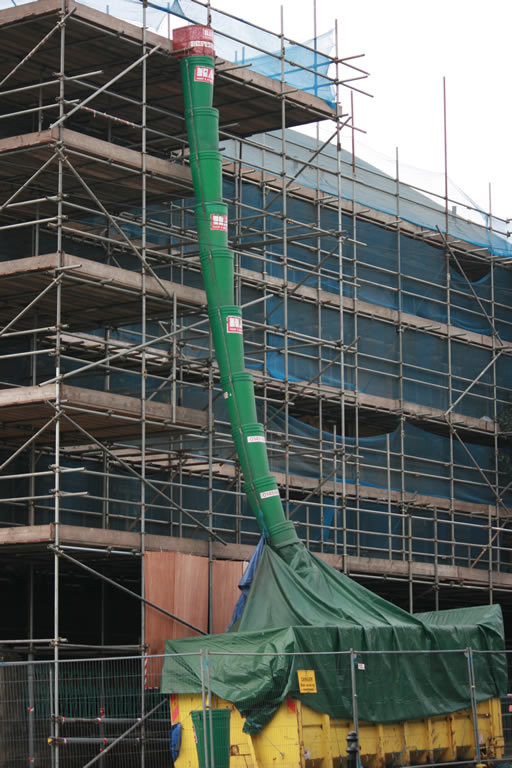Rubble chute
A rubble chute is used to enable the safe and efficient transfer of debris/materials from a structure’s scaffold to a skip at street level. The simple concept is that several cylindrical dustbin-like sections are linked together using chains and hung from the side of a building or scaffold. The reinforced rubber cylinders, together with steel inner lining, are tapered and fit together, at effective lengths of 1-metre.
The usual dimensions of the sections are 510 mm diameter that tapers to 380 mm. There must be metal ring reinforcement every 6 section units. Overall length should not exceed 40 sections and should be tied back to the scaffold every 6m.
A steel top hipper is required to provide an improved aperture at the point where debris is being placed into the chute to prevent unnecessary spillage. Y-sections can be used to allow debris to be placed into the chute at intermediate positions along its length. The chute is not designed to cope with large, long or heavy items such as structural beams, timbers, poles, etc. Neither should hazardous, corrosive or liquid materials be disposed of down the chute.
The chute is assembled horizontally at ground level before being lifted into position by a scaffold hoist, with additional sections being added to the bottom in order to achieve the required length.
Rubble chutes should be hosed down regularly so as to avoid unnecessary damage or obstruction.
Local authorities may need to give permission or special licences for rubble chutes to be erected on, across or adjacent to a public highway, and may require safety barriers, cones, warning lights, tape, signs and so on. Skips may need to be covered to prevent the spread of dust and other debris.
[edit] Find out more
[edit] Related articles on Designing Buildings Wiki
- Building wraps.
- Construction plant.
- Construction skip.
- Construction tools.
- Debris netting.
- Equipment in buildings.
- Excavating plant.
- Firefighting lift.
- Road sweeper.
- Scaffolding.
- Site waste management plan.
- Recycling.
- Temporary works.
- Types of cranes.
[edit] External references
- ‘Building Construction Handbook’ (6th ed.), CHUDLEY, R., GREENO, R., Butterworth-Heinemann, (2007)
Featured articles and news
RTPI leader to become new CIOB Chief Executive Officer
Dr Victoria Hills MRTPI, FICE to take over after Caroline Gumble’s departure.
Social and affordable housing, a long term plan for delivery
The “Delivering a Decade of Renewal for Social and Affordable Housing” strategy sets out future path.
A change to adoptive architecture
Effects of global weather warming on architectural detailing, material choice and human interaction.
The proposed publicly owned and backed subsidiary of Homes England, to facilitate new homes.
How big is the problem and what can we do to mitigate the effects?
Overheating guidance and tools for building designers
A number of cool guides to help with the heat.
The UK's Modern Industrial Strategy: A 10 year plan
Previous consultation criticism, current key elements and general support with some persisting reservations.
Building Safety Regulator reforms
New roles, new staff and a new fast track service pave the way for a single construction regulator.
Architectural Technologist CPDs and Communications
CIAT CPD… and how you can do it!
Cooling centres and cool spaces
Managing extreme heat in cities by directing the public to places for heat stress relief and water sources.
Winter gardens: A brief history and warm variations
Extending the season with glass in different forms and terms.
Restoring Great Yarmouth's Winter Gardens
Transforming one of the least sustainable constructions imaginable.
Construction Skills Mission Board launch sector drive
Newly formed government and industry collaboration set strategy for recruiting an additional 100,000 construction workers a year.
New Architects Code comes into effect in September 2025
ARB Architects Code of Conduct and Practice available with ongoing consultation regarding guidance.
Welsh Skills Body (Medr) launches ambitious plan
The new skills body brings together funding and regulation of tertiary education and research for the devolved nation.
Paul Gandy FCIOB announced as next CIOB President
Former Tilbury Douglas CEO takes helm.
UK Infrastructure: A 10 Year Strategy. In brief with reactions
With the National Infrastructure and Service Transformation Authority (NISTA).























